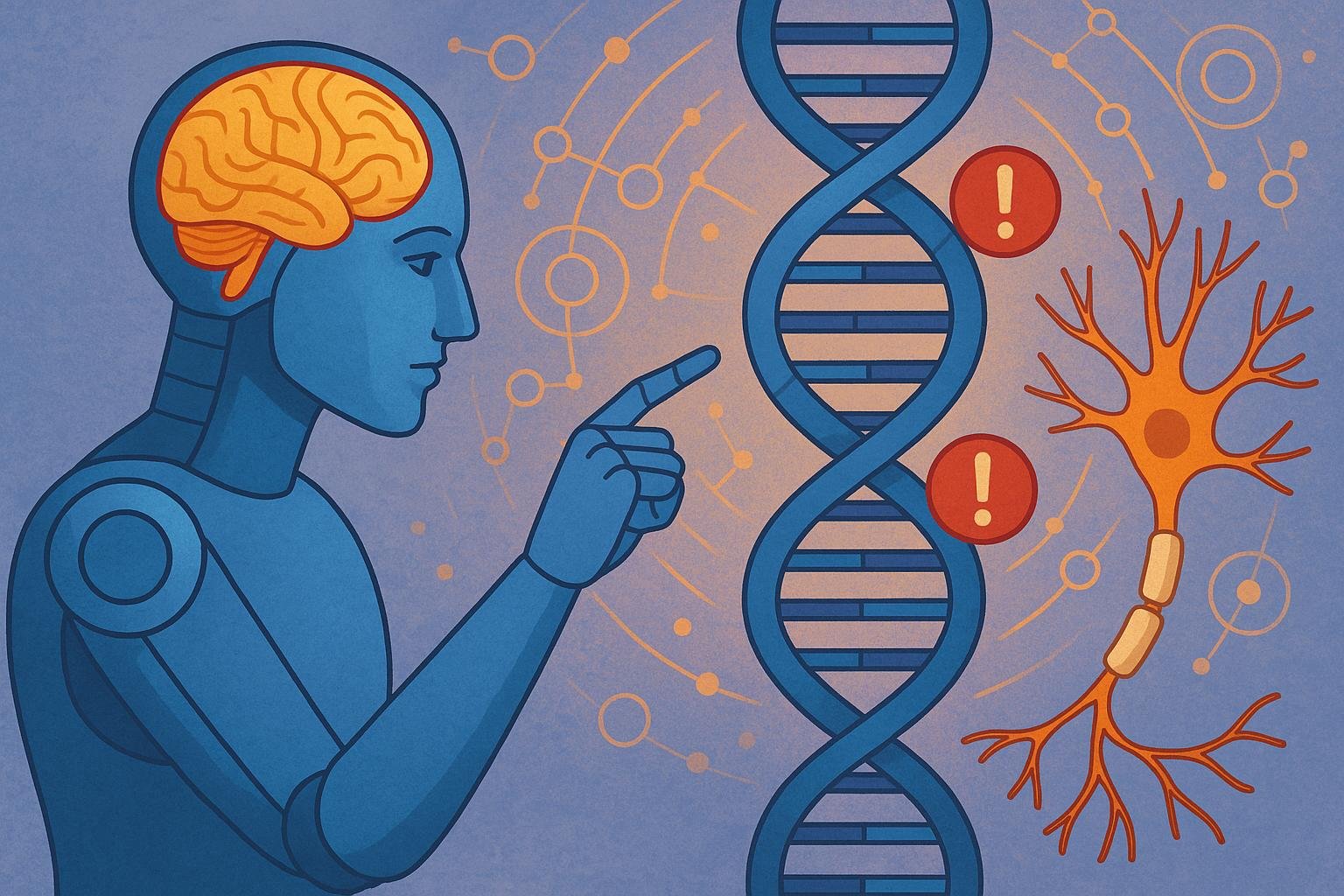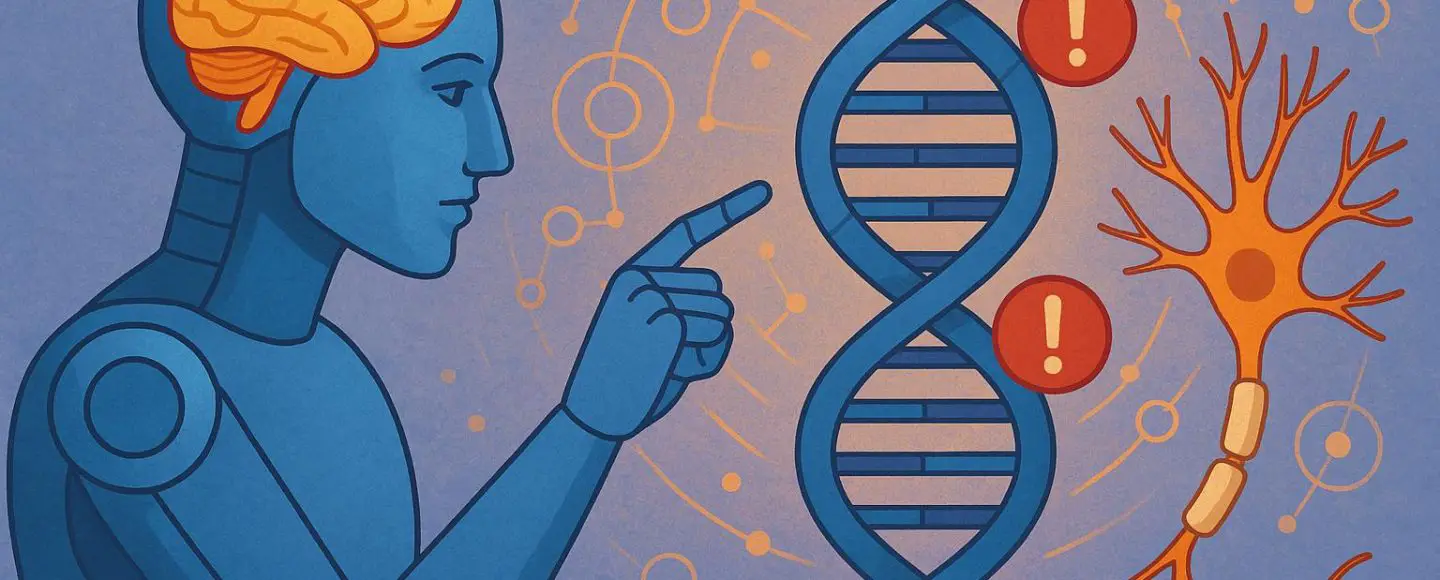

AI Uncovers New Sclerosis Risk Genes
AI Uncovers New Sclerosis Risk Genes describes how researchers are using artificial intelligence and exome sequencing to advance our understanding of systemic sclerosis, a rare autoimmune condition with complex genetics. A global team applied machine learning models to large datasets and identified ten new genes that may increase the risk of developing the disease. The combination of computational science and genomic data marks progress toward more accurate diagnostics and potential treatment strategies.
Key Takeaways
- Ten new systemic sclerosis risk genes were identified using AI and whole-exome sequencing from large international cohorts.
- The analyses included both common and rare variants, offering insights into immune pathways related to the disease.
- Machine learning methods added depth to traditional genome-wide association study techniques.
- The findings are still at the research stage and are not yet approved for clinical use.
Genetic Challenges in Understanding Systemic Sclerosis
Systemic sclerosis, also referred to as scleroderma, is an autoimmune disease affecting the connective tissue, leading to fibrosis and vascular damage. While previous genome-wide association studies have found a few risk regions, many potential genetic contributors remain undiscovered. The rarity of SSc, along with its complexity, creates challenges in collecting sufficiently large datasets. Traditional approaches often detect only the most common variants and may miss subtler genetic factors.
This disease significantly affects organ function and quality of life in those diagnosed. As with other autoimmune disorders like lupus and rheumatoid arthritis, unraveling the genetic basis of SSc may lead to targeted therapy and better stratification of patients.
Exome Sequencing Offers a Closer Look
In this study, scientists used whole-exome sequencing to examine only the protein-coding parts of the genome. These areas account for just a small portion of the total DNA but include the majority of mutations that influence disease. By sequencing over 10,000 individuals from multiple ancestry backgrounds, they identified both common and rare variants that could influence immune response and fibrosis development.
Rare variants often go undetected in broad studies, yet they may hold critical clues to disease development. Researchers used gene-level tests to evaluate the combined effect of grouped variants within genes, making the data more informative for conditions like SSc.
How AI Helps Identify Disease Genes
Artificial intelligence allowed the research team to analyze complex patterns in genomic data. They used models such as random forests and XGBoost to classify samples and rank potential risk genes. These tools helped pinpoint interactions among genes and variants, going beyond what single-variant analysis could reveal. AI also enabled integration of additional datasets like gene expression and immune cell profiles to determine biological relevance.
This strategy is transforming the discovery process for genetic conditions. For a detailed look at its broader uses, see AI in genomics and genetic analysis.
Ten Newly Identified Genes Linked to Systemic Sclerosis
Researchers named ten genes that had not been previously associated with systemic sclerosis in large-scale studies:
- RFX1: Involved in antigen presentation and T-cell immune function.
- EMP1: Regulates epithelial cell function and impacts immune response.
- DYSF: Supports cell membrane repair and has roles in inflammation.
- IL12RB2: Part of the receptor for interleukin-12, essential for Th1 responses.
- CSF3R: A receptor that controls neutrophil production and immune activity.
- STAT5B: Key transcription factor triggered by cytokine signaling.
- SLC15A4: Affects immune signaling via Toll-like receptors.
- ZNF77: A transcription-related gene potentially involved in immune regulation.
- INHBB: Belongs to the TGF-β family, possibly influencing fibrosis pathways.
- PRAM1: Expressed in myeloid cells and linked to immune cell adhesion and activation.
These genes highlight how different biological systems contribute to disease, including antigen presentation, fibrosis, cytokine interaction, and cellular repair. Several of the proteins encoded by these genes are active in immune-regulating tissues and pathways.
Validation with International Cohorts
To ensure accuracy, the research involved genomic data from multiple populations across Europe, North America, and Asia. Every cohort followed standardized sequencing and analysis protocols, reducing the chance of error or population bias. This approach supports consistency and makes the findings more applicable to global healthcare efforts.
Comparing to Prior Genetic Studies
Earlier studies identified genes like STAT4, IRF5, and CD247 as associated with SSc. These mostly emerged from SNP-based genotyping arrays and focused on common variants. The current study differed by detecting rare variants and applying machine learning to assess complex gene networks. For instance, findings involving genes like EMP1 and PRAM1 were absent from most previous studies due to technological and analytic limitations.
This shift in methodology reflects the broader move toward more integrated, data-driven techniques such as those described in AI applications for understanding autoimmune diseases.
Impact on Medical Research and Healthcare
These results have strong research value but are not ready for clinical use yet. Genetic tests based on these discoveries should not be used outside of research settings. The genes presented serve as a starting point for future studies in lab models, patient subgrouping, and possible therapy design.
As more data become available, these findings may eventually support approaches like predictive diagnostics for disease detection. Precision medicine requires stratifying patients based on underlying biology rather than symptoms, and this genetic information makes progress in that direction.
Transformative Potential of AI in Genomics
Artificial intelligence offers powerful tools to solve problems in genetic medicine. By analyzing vast numbers of variables, AI can uncover patterns that might otherwise go unnoticed. In this study, models clustered gene expression levels, prioritized genomic findings, and supported polygenic risk scoring models. These tools helped reveal the hidden architecture of systemic sclerosis.
The use of AI is also making a difference in related areas such as AI-enabled drug discovery and development, where similar methods are used to identify new treatment targets.
FAQ’s
What is exome sequencing?
Exome sequencing is a genomic technique that analyzes the protein-coding regions of genes, known as exons, which make up about 1–2% of the human genome.
Why is exome sequencing important?
Although exons are a small portion of the genome, they contain 85% of disease-causing mutations. Exome sequencing helps identify these mutations in individuals with unexplained genetic conditions.
Who should consider exome sequencing?
It is often used for patients with undiagnosed rare diseases, inherited disorders, or complex symptoms that do not fit a clear diagnosis.
How is it different from whole genome sequencing?
Whole genome sequencing reads the entire DNA sequence, including non-coding regions. Exome sequencing focuses only on exons, making it faster and more cost-effective in many cases.
Is exome sequencing definitive?
Not always. It may identify variants of uncertain significance (VUS) that require further clinical interpretation or family testing to confirm their role in disease.
What is systemic sclerosis?
Systemic sclerosis, or scleroderma, is a rare autoimmune disease characterized by hardening and tightening of the skin and connective tissues. It can also affect internal organs.
What are the symptoms?
Common symptoms include skin thickening, Raynaud’s phenomenon, joint stiffness, digestive issues, and shortness of breath.
What causes systemic sclerosis?
The exact cause is unknown, but it involves an overactive immune system that leads to fibrosis, blood vessel damage, and inflammation.
How is it diagnosed?
Diagnosis is based on clinical symptoms, blood tests (such as ANA and anti-Scl-70), imaging, and sometimes skin or organ biopsies.
Is there a cure?
There is no cure, but treatments such as immunosuppressants, vasodilators, and physical therapy can help manage symptoms and slow progression.
What is precision medicine?
Precision medicine tailors treatment and prevention strategies based on individual variability in genes, environment, and lifestyle.
How is AI used in precision medicine?
AI analyzes large datasets from genomics, medical imaging, and electronic health records to detect patterns and personalize care.
Can AI predict disease risk?
Yes. AI models can assess genetic and clinical data to predict susceptibility to diseases like cancer, diabetes, and heart conditions.
How does AI help clinicians?
AI assists in diagnosis, treatment selection, and patient stratification, enabling more informed decisions with greater speed and accuracy.
Are there risks with using AI in healthcare?
AI models can reflect bias or yield false positives if not properly validated. Human oversight and rigorous evaluation are essential.
Why is genetic testing important for rare diseases?
It helps identify the underlying genetic cause of a disease, enabling more accurate diagnosis, family planning, and targeted treatment.
When should genetic testing be considered?
It is often recommended when symptoms suggest a genetic condition or when there’s a family history of a rare disorder.
What types of genetic tests are used?
Common tests include single-gene testing, panel testing, exome sequencing, and whole genome sequencing.
Will genetic testing always find an answer?
Not always. Sometimes results are inconclusive or identify variants of unknown significance, requiring further research or follow-up testing.
Can genetic testing guide treatment?
Yes. In some cases, it can identify mutations that qualify for targeted therapies or clinical trials tailored to specific genetic changes.
References
Brynjolfsson, Erik, and Andrew McAfee. The Second Machine Age: Work, Progress, and Prosperity in a Time of Brilliant Technologies. W. W. Norton & Company, 2016.
Marcus, Gary, and Ernest Davis. Rebooting AI: Building Artificial Intelligence We Can Trust. Vintage, 2019.
Russell, Stuart. Human Compatible: Artificial Intelligence and the Problem of Control. Viking, 2019.
Webb, Amy. The Big Nine: How the Tech Titans and Their Thinking Machines Could Warp Humanity. PublicAffairs, 2019.
Crevier, Daniel. AI: The Tumultuous History of the Search for Artificial Intelligence. Basic Books, 1993.



